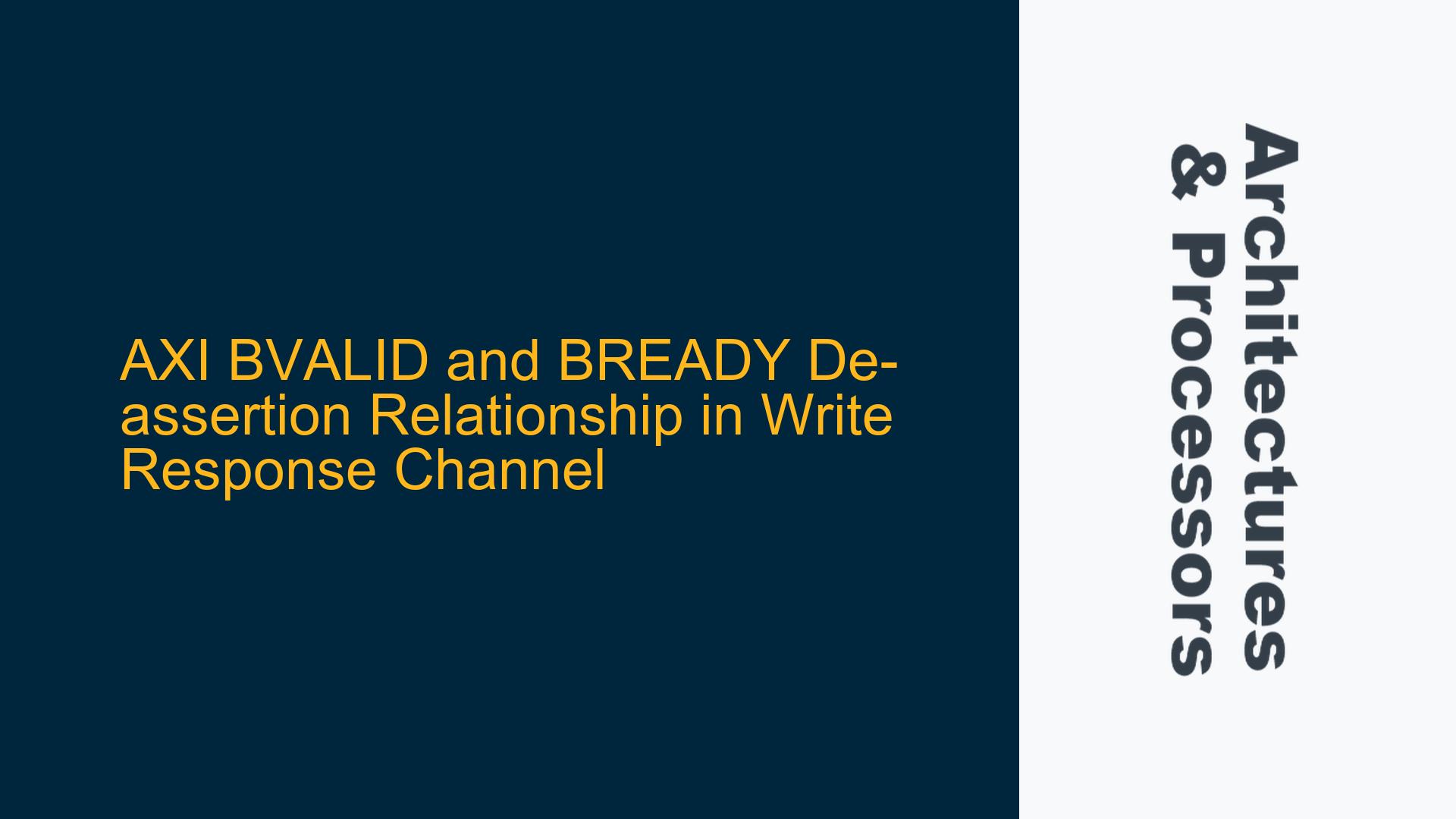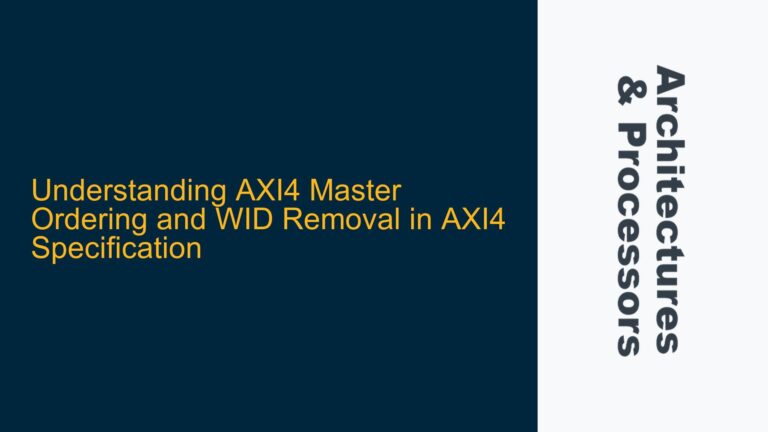BVALID and BREADY Handshake Protocol in AXI Write Response Channel
The AXI (Advanced eXtensible Interface) protocol, part of the ARM AMBA (Advanced Microcontroller Bus Architecture) family, is widely used in SoC designs for high-performance data transfer between components. The protocol defines five independent channels: Read Address, Read Data, Write Address, Write Data, and Write Response. The Write Response channel, which uses the BVALID and BREADY signals, is critical for ensuring that write transactions are properly acknowledged by the slave device.
In the AXI protocol, the BVALID signal is driven by the slave to indicate that the write response is valid and available on the BRESP signal. The BREADY signal, driven by the master, indicates that the master is ready to accept the write response. The handshake between BVALID and BREADY is fundamental to the completion of a write transaction. The protocol allows these signals to assert in any order, but their de-assertion behavior is more constrained and requires careful consideration to avoid protocol violations and ensure correct system operation.
The de-assertion of BVALID and BREADY signals is not explicitly detailed in the AXI specification, leading to potential ambiguities in implementation. Understanding the relationship between these signals during de-assertion is crucial for designing compliant AXI interfaces and avoiding functional errors in the system. This analysis delves into the de-assertion behavior of BVALID and BREADY, exploring the underlying rules, potential causes of issues, and practical solutions for ensuring protocol compliance.
BVALID De-assertion Constraints and BREADY Dependency
The de-assertion of BVALID is tightly coupled with the completion of the handshake on the Write Response channel. According to the AXI protocol, BVALID can only be de-asserted after the handshake has completed, which occurs when both BVALID and BREADY are sampled high on the same rising edge of the ACLK (AXI Clock). This constraint ensures that the write response is properly transferred from the slave to the master before BVALID is de-asserted. If BVALID is de-asserted prematurely, the master may not receive the write response, leading to incomplete transactions and potential system errors.
BREADY, on the other hand, is not directly constrained by the handshake completion. The master can assert or de-assert BREADY based on its internal state and readiness to accept write responses. BREADY can transition from asserted to de-asserted and back to asserted multiple times, independent of BVALID, as long as these transitions occur on rising edges of ACLK. This flexibility allows the master to manage its internal buffer space and processing capacity dynamically. However, the master must ensure that BREADY is asserted when the slave is ready to transfer the write response (i.e., when BVALID is high) to avoid stalling the transaction.
The relationship between BVALID and BREADY during de-assertion can be summarized as follows: BVALID de-assertion is strictly dependent on the completion of the handshake, while BREADY de-assertion is governed by the master’s internal logic and can occur independently of BVALID. This asymmetry in de-assertion behavior can lead to timing and synchronization issues if not properly managed in the design.
Protocol Violations Due to Improper BVALID and BREADY De-assertion
Improper handling of BVALID and BREADY de-assertion can result in several protocol violations and functional errors. One common issue is the premature de-assertion of BVALID before the handshake is completed. This can occur if the slave incorrectly assumes that the master has accepted the write response and de-asserts BVALID without waiting for BREADY to be high. In such cases, the master may miss the write response, leading to incomplete transactions and potential data corruption.
Another issue arises when BREADY is de-asserted while BVALID is still high. If the master de-asserts BREADY before the slave de-asserts BVALID, the handshake cannot complete, and the write response remains pending. This can cause the slave to stall, waiting indefinitely for BREADY to be asserted again. Such scenarios can lead to deadlock conditions, especially in systems with multiple masters and slaves sharing the same AXI bus.
Additionally, improper synchronization between BVALID and BREADY de-assertion can result in metastability issues. If BVALID and BREADY transitions are not properly synchronized with ACLK, the signals may violate setup and hold time requirements, leading to unpredictable behavior in the system. These issues are particularly challenging to debug, as they may manifest intermittently and depend on specific timing conditions.
Implementing Correct BVALID and BREADY De-assertion Behavior
To ensure correct de-assertion behavior of BVALID and BREADY, designers must adhere to the following guidelines:
-
BVALID De-assertion After Handshake Completion: The slave must only de-assert BVALID after confirming that the handshake has completed. This can be achieved by monitoring both BVALID and BREADY signals and de-asserting BVALID only when both signals are high on the same rising edge of ACLK. Implementing this logic requires careful state machine design in the slave interface to ensure that BVALID is held high until the handshake is confirmed.
-
BREADY Assertion Based on Master Readiness: The master should assert BREADY only when it is ready to accept a write response. If the master’s internal buffers are full or it is unable to process the response, BREADY should be de-asserted to prevent stalling the slave. The master must also ensure that BREADY is re-asserted promptly when it becomes ready again, to avoid unnecessary delays in transaction completion.
-
Synchronization of Signal Transitions: Both BVALID and BREADY transitions must be synchronized with ACLK to avoid metastability issues. This can be achieved by using clock domain crossing (CDC) techniques, such as double-flopping, when transferring signals between different clock domains. Proper synchronization ensures that setup and hold time requirements are met, reducing the risk of timing violations.
-
Verification of De-assertion Behavior: The de-assertion behavior of BVALID and BREADY should be thoroughly verified using simulation and formal verification techniques. Simulation testbenches should include corner cases, such as simultaneous transitions of BVALID and BREADY, to ensure that the design handles all possible scenarios correctly. Formal verification can be used to prove that the design adheres to the AXI protocol rules, including the de-assertion constraints.
By following these guidelines, designers can ensure that the de-assertion of BVALID and BREADY signals is handled correctly, avoiding protocol violations and ensuring reliable operation of the AXI interface. Proper implementation and verification of these signals are critical for the overall performance and correctness of ARM-based SoC designs.






